2005 JEEP LIBERTY child restraint
[x] Cancel search: child restraintPage 67 of 424
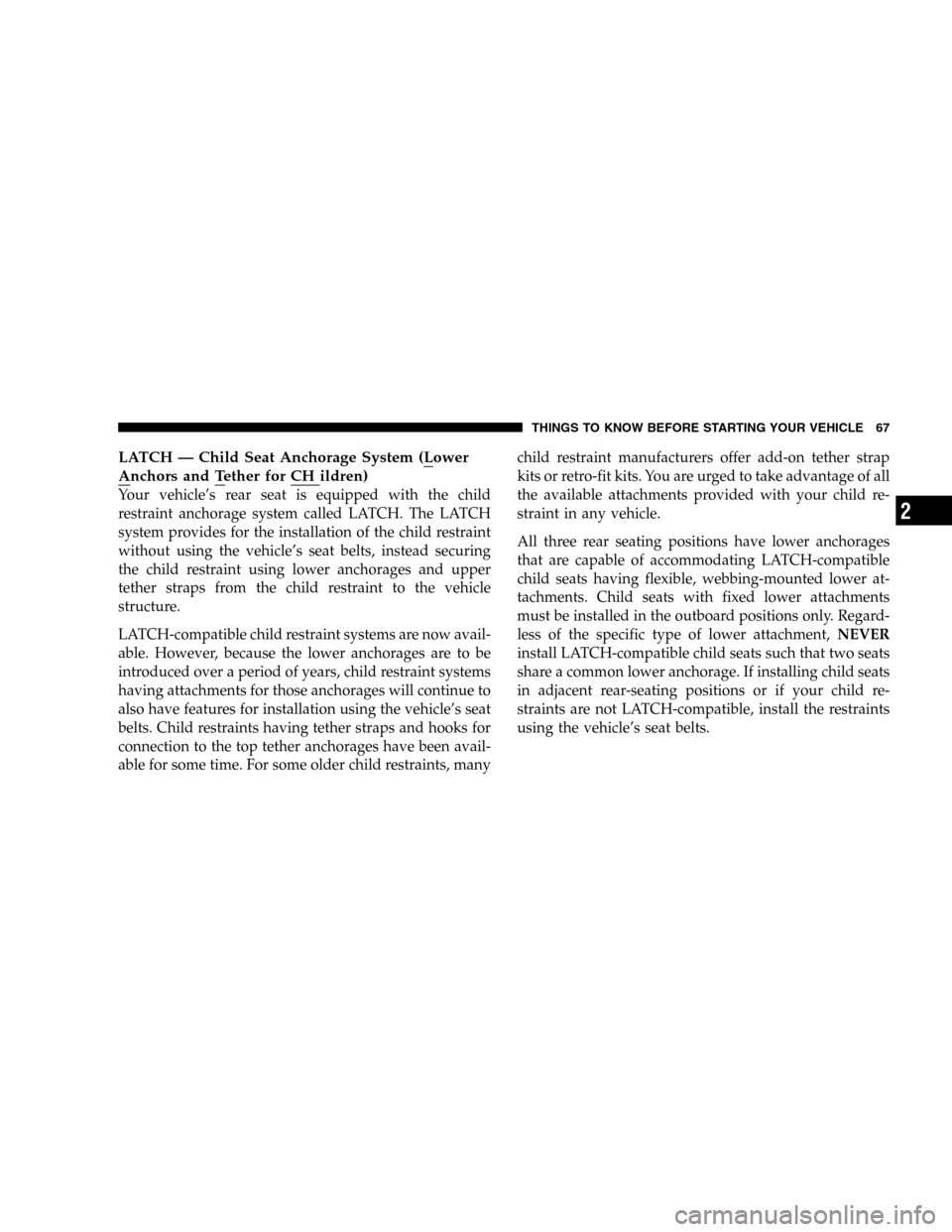
LATCH — Child Seat Anchorage System (Lower
Anchors and Tether for CH ildren)
Your vehicle’s rear seat is equipped with the child
restraint anchorage system called LATCH. The LATCH
system provides for the installation of the child restraint
without using the vehicle’s seat belts, instead securing
the child restraint using lower anchorages and upper
tether straps from the child restraint to the vehicle
structure.
LATCH-compatible child restraint systems are now avail-
able. However, because the lower anchorages are to be
introduced over a period of years, child restraint systems
having attachments for those anchorages will continue to
also have features for installation using the vehicle’s seat
belts. Child restraints having tether straps and hooks for
connection to the top tether anchorages have been avail-
able for some time. For some older child restraints, manychild restraint manufacturers offer add-on tether strap
kits or retro-fit kits. You are urged to take advantage of all
the available attachments provided with your child re-
straint in any vehicle.
All three rear seating positions have lower anchorages
that are capable of accommodating LATCH-compatible
child seats having flexible, webbing-mounted lower at-
tachments. Child seats with fixed lower attachments
must be installed in the outboard positions only. Regard-
less of the specific type of lower attachment,NEVER
install LATCH-compatible child seats such that two seats
share a common lower anchorage. If installing child seats
in adjacent rear-seating positions or if your child re-
straints are not LATCH-compatible, install the restraints
using the vehicle’s seat belts.
THINGS TO KNOW BEFORE STARTING YOUR VEHICLE 67
2
Page 68 of 424
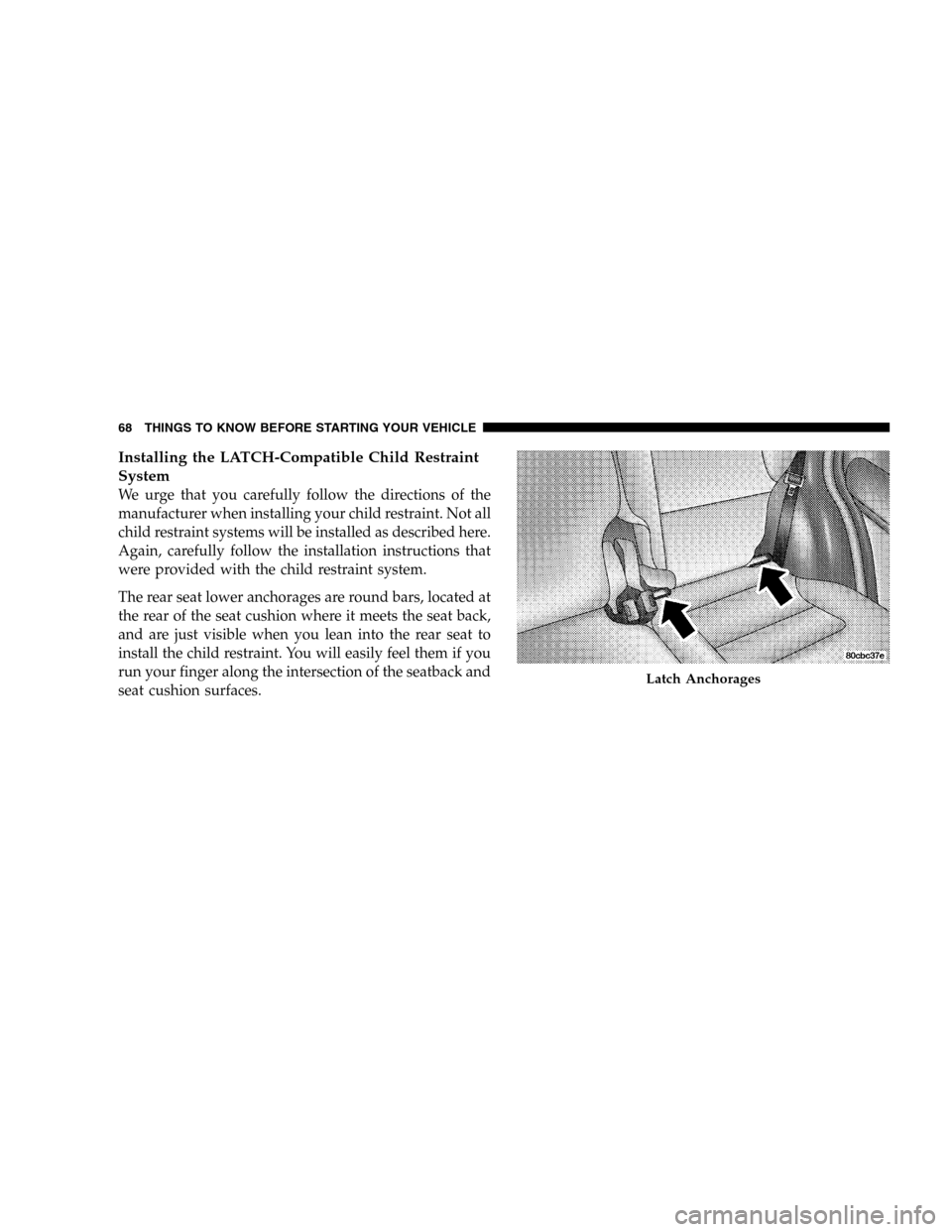
Installing the LATCH-Compatible Child Restraint
System
We urge that you carefully follow the directions of the
manufacturer when installing your child restraint. Not all
child restraint systems will be installed as described here.
Again, carefully follow the installation instructions that
were provided with the child restraint system.
The rear seat lower anchorages are round bars, located at
the rear of the seat cushion where it meets the seat back,
and are just visible when you lean into the rear seat to
install the child restraint. You will easily feel them if you
run your finger along the intersection of the seatback and
seat cushion surfaces.
Latch Anchorages
68 THINGS TO KNOW BEFORE STARTING YOUR VEHICLE
Page 69 of 424
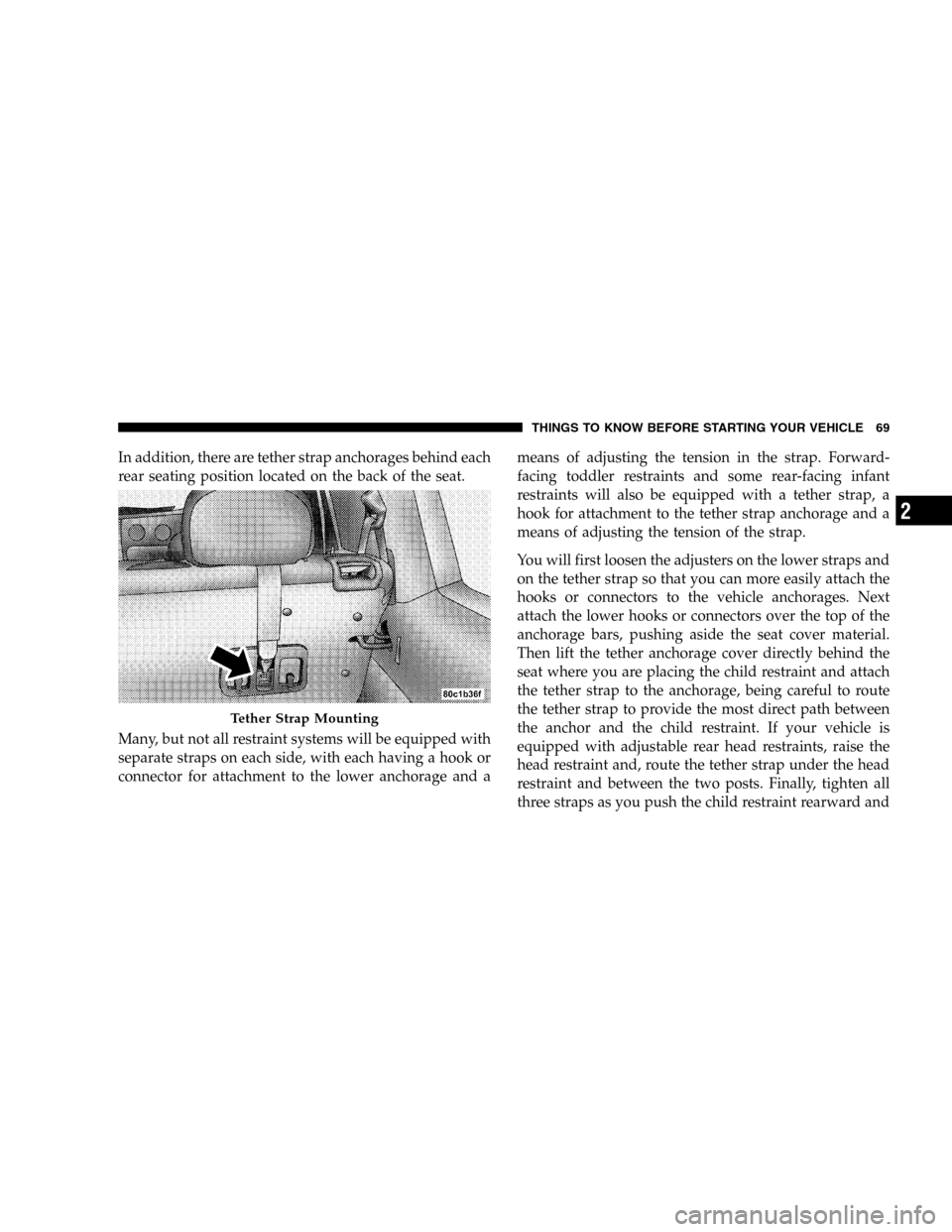
In addition, there are tether strap anchorages behind each
rear seating position located on the back of the seat.
Many, but not all restraint systems will be equipped with
separate straps on each side, with each having a hook or
connector for attachment to the lower anchorage and ameans of adjusting the tension in the strap. Forward-
facing toddler restraints and some rear-facing infant
restraints will also be equipped with a tether strap, a
hook for attachment to the tether strap anchorage and a
means of adjusting the tension of the strap.
You will first loosen the adjusters on the lower straps and
on the tether strap so that you can more easily attach the
hooks or connectors to the vehicle anchorages. Next
attach the lower hooks or connectors over the top of the
anchorage bars, pushing aside the seat cover material.
Then lift the tether anchorage cover directly behind the
seat where you are placing the child restraint and attach
the tether strap to the anchorage, being careful to route
the tether strap to provide the most direct path between
the anchor and the child restraint. If your vehicle is
equipped with adjustable rear head restraints, raise the
head restraint and, route the tether strap under the head
restraint and between the two posts. Finally, tighten all
three straps as you push the child restraint rearward and
Tether Strap Mounting
THINGS TO KNOW BEFORE STARTING YOUR VEHICLE 69
2
Page 70 of 424
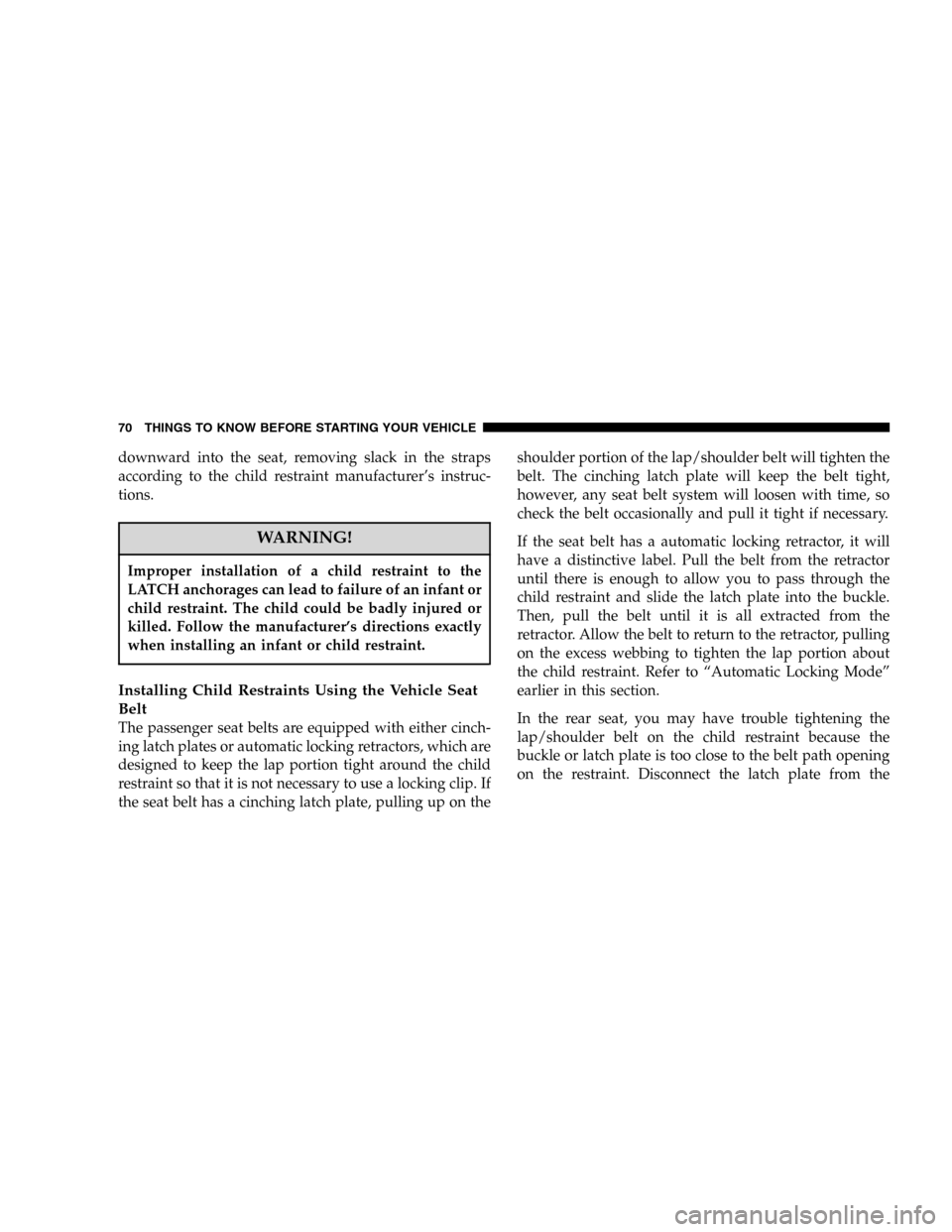
downward into the seat, removing slack in the straps
according to the child restraint manufacturer’s instruc-
tions.
WARNING!
Improper installation of a child restraint to the
LATCH anchorages can lead to failure of an infant or
child restraint. The child could be badly injured or
killed. Follow the manufacturer’s directions exactly
when installing an infant or child restraint.
Installing Child Restraints Using the Vehicle Seat
Belt
The passenger seat belts are equipped with either cinch-
ing latch plates or automatic locking retractors, which are
designed to keep the lap portion tight around the child
restraint so that it is not necessary to use a locking clip. If
the seat belt has a cinching latch plate, pulling up on theshoulder portion of the lap/shoulder belt will tighten the
belt. The cinching latch plate will keep the belt tight,
however, any seat belt system will loosen with time, so
check the belt occasionally and pull it tight if necessary.
If the seat belt has a automatic locking retractor, it will
have a distinctive label. Pull the belt from the retractor
until there is enough to allow you to pass through the
child restraint and slide the latch plate into the buckle.
Then, pull the belt until it is all extracted from the
retractor. Allow the belt to return to the retractor, pulling
on the excess webbing to tighten the lap portion about
the child restraint. Refer to “Automatic Locking Mode”
earlier in this section.
In the rear seat, you may have trouble tightening the
lap/shoulder belt on the child restraint because the
buckle or latch plate is too close to the belt path opening
on the restraint. Disconnect the latch plate from the
70 THINGS TO KNOW BEFORE STARTING YOUR VEHICLE
Page 71 of 424
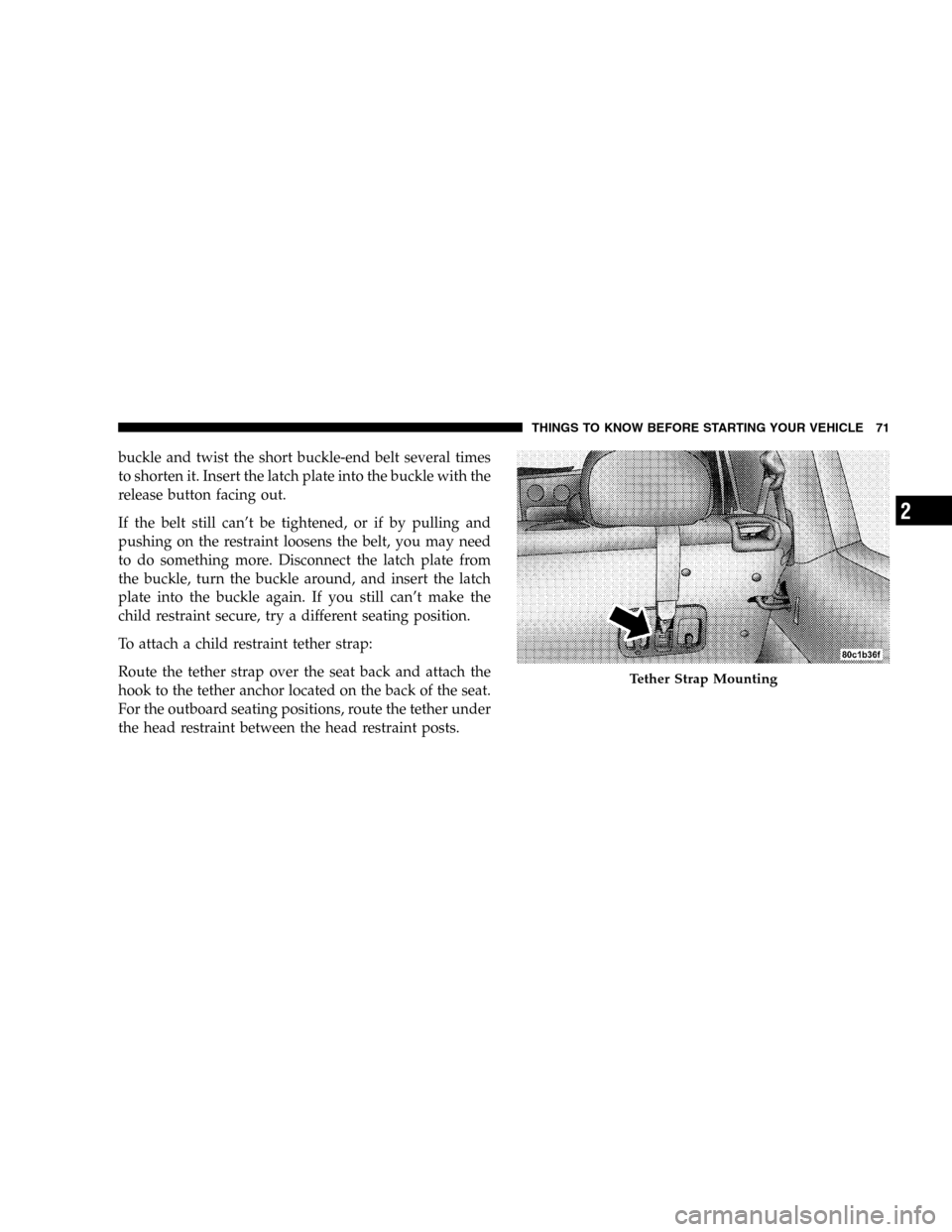
buckle and twist the short buckle-end belt several times
to shorten it. Insert the latch plate into the buckle with the
release button facing out.
If the belt still can’t be tightened, or if by pulling and
pushing on the restraint loosens the belt, you may need
to do something more. Disconnect the latch plate from
the buckle, turn the buckle around, and insert the latch
plate into the buckle again. If you still can’t make the
child restraint secure, try a different seating position.
To attach a child restraint tether strap:
Route the tether strap over the seat back and attach the
hook to the tether anchor located on the back of the seat.
For the outboard seating positions, route the tether under
the head restraint between the head restraint posts.
Tether Strap Mounting
THINGS TO KNOW BEFORE STARTING YOUR VEHICLE 71
2
Page 72 of 424
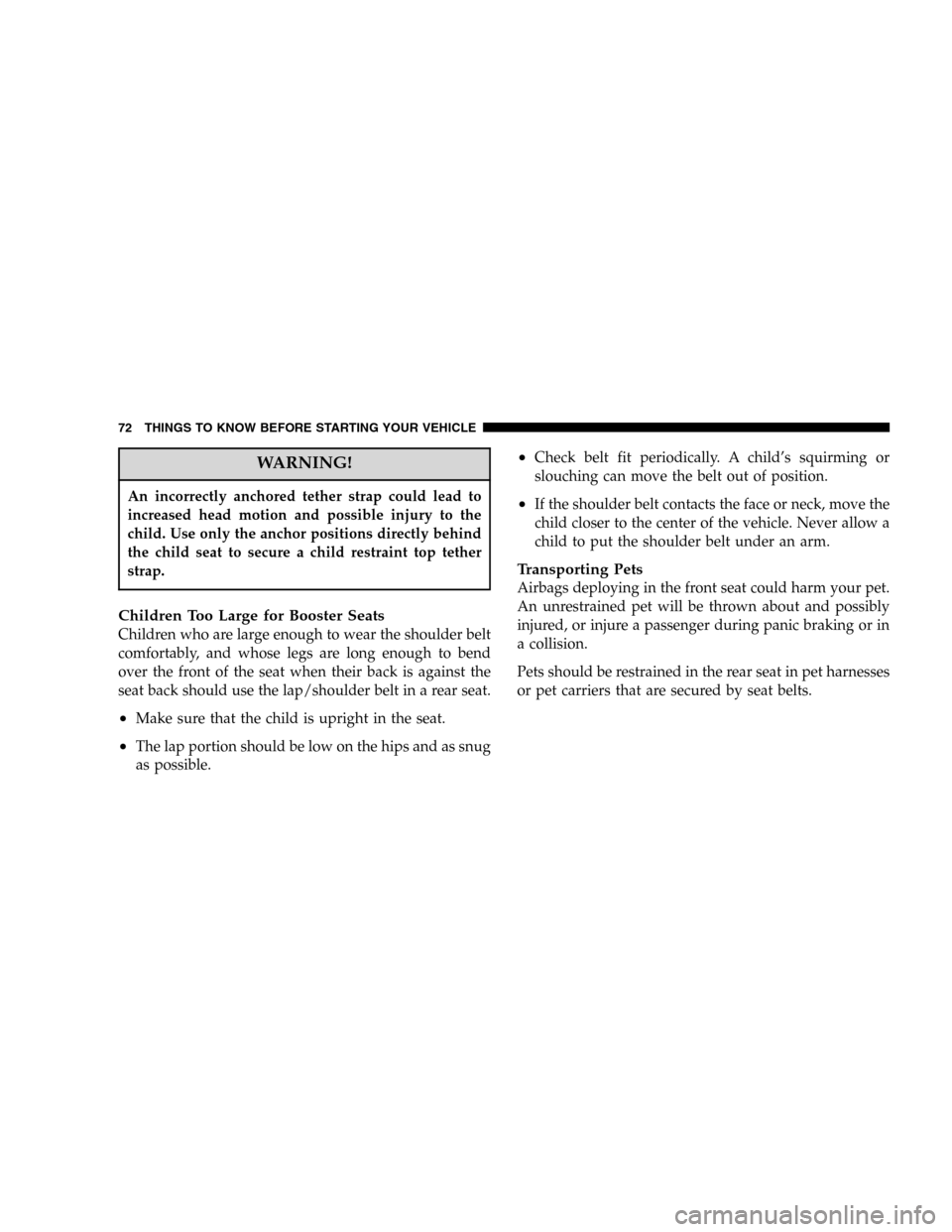
WARNING!
An incorrectly anchored tether strap could lead to
increased head motion and possible injury to the
child. Use only the anchor positions directly behind
the child seat to secure a child restraint top tether
strap.
Children Too Large for Booster Seats
Children who are large enough to wear the shoulder belt
comfortably, and whose legs are long enough to bend
over the front of the seat when their back is against the
seat back should use the lap/shoulder belt in a rear seat.
•Make sure that the child is upright in the seat.
•The lap portion should be low on the hips and as snug
as possible.
•Check belt fit periodically. A child’s squirming or
slouching can move the belt out of position.
•If the shoulder belt contacts the face or neck, move the
child closer to the center of the vehicle. Never allow a
child to put the shoulder belt under an arm.
Transporting Pets
Airbags deploying in the front seat could harm your pet.
An unrestrained pet will be thrown about and possibly
injured, or injure a passenger during panic braking or in
a collision.
Pets should be restrained in the rear seat in pet harnesses
or pet carriers that are secured by seat belts.
72 THINGS TO KNOW BEFORE STARTING YOUR VEHICLE
Page 402 of 424

Caution, Exhaust Gas...................73,141
CD Changer........................187,193
CD Player..................184,189,191,195,198
CD Player Maintenance................... 211
Cellular Phone........................85,211
Center High Mounted Stop Light............ 355
Chains, Tire............................ 274
Changing A Flat Tire..................... 294
Charging System Light.................... 170
Chart, Tire Sizing........................ 255
Check Engine Light (Malfunction Indicator Light) . 310
Child Restraint......................63,68,70
Child Restraint Tether Anchors.............67,68
Child Safety Locks........................ 24
Climate Control......................... 212
Clock................................ 176
Clutch Interlocking Ignition System........220,229
Command-Trac Operation.................. 236
Compact Disc Maintenance................. 211Compact Disc Player..................178,184
Compass.............................. 137
Compass Calibration..................... 137
Compass Variance....................... 138
Computer, Trip/Travel.................... 135
Console, Overhead....................... 129
Contract, Service........................ 392
Converter, Catalytic...................... 317
Cool Down, Turbo....................... 224
Cooling System......................... 325
Adding Coolant (Antifreeze).............. 327
Coolant Capacity...................... 356
Coolant Level......................... 328
Disposal of Used Coolant................ 328
Drain, Flush, and Refill.................. 326
Inspection........................... 325
Points to Remember.................... 329
Pressure Cap......................... 327
Radiator Cap......................... 327
402 INDEX
Page 412 of 424

Rear Wiper/Washer...................... 156
Rearview Mirrors........................ 81
Reclining Front Seats..................... 109
Recommended Fluids, Lubricants and Genuine
Parts............................... 357
Recreational Towing...................... 287
Shifting into Transfer Case Neutral (N)....... 287
Shifting out of Transfer Case Neutral (N)..... 288
Reformulated Gasoline.................... 277
Refrigerant............................ 322
Reminder, Lights On..................... 120
Reminder, Seat Belt....................... 46
Remote Keyless Entry..................... 25
Remote Sound System Controls.............. 208
Replacement Keys........................ 17
Replacement Parts....................... 311
Replacement Tires....................... 266
Reporting Safety Defects................... 395
Re-Priming Diesel Fuel System.............. 225Restraint, Head......................... 110
Restraints, Child......................... 63
Restraints, Infant......................... 64
Restraints, Occupant...................... 37
Retractable Cargo Area Cover............... 151
Rocking Vehicle When Stuck................ 236
Roof Rack............................. 159
Rotation, Tires.......................... 275
Safety Checks Inside Vehicle................. 74
Safety Checks Outside Vehicle............... 75
Safety Defects, Reporting.................. 395
Safety, Exhaust Gas....................... 73
Safety Information, Tire................... 254
Safety Tips............................. 73
Satellite Radio.......................... 203
Satellite Radio Antenna................... 207
Schedule, Maintenance.................360,378
Seat Belt Reminder....................... 46
412 INDEX